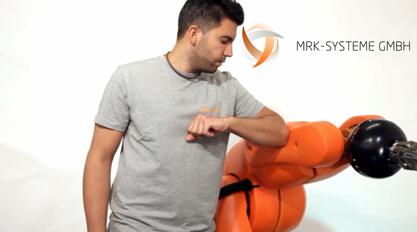What is a Force Limited Robot?

Posted on Feb 10, 2015 11:12 AM. 3 min read time
With the relatively recent introduction of collaborative robots into the robotic market, a lot of different designs and concepts have been developed to insure human-robot collaboration. A couple years ago, these types of technologies weren't developed since this type of collaboration wasn't even possible. Now with the mass introduction of robots doing collaborative operations, it is logical to see more and more force limited robot concepts developed by robot manufacturers and integrators.
Force Limited Robots
The base-line is: the robots have a force threshold to prevent severe impact with a human co-worker. So either the force sensors are in the robot's joints or on the robot's external cover, it is designed to stop when an external force is sensed to prevent serious injuries. Most robot manufacturers offer adjustable force limitation to some degree, so the programmer can adjust the right settings for the intended application. You should also notice that to reduce the impact on a surface, you have to reduce the kinetic energy impact on this surface too. This means two things; the speed and contact surface have to be considered.

A force limited robot will, most of the time, be operating under reduced speed to reduce the kinematic energy of its motions. The slower, the less impact on the human worker. Setting this parameter can make a huge difference in some applications. For example, for a given speed, if the robot arm is fully extended or fully folded, the impact of the robot end (wrist or tool) on the surface will not be the same. Make sure to consider this parameter in your robotic cell.
The contact surface of the robot on the impact surface is also important to consider. Since, pressure is force divided by surface area (P=F[N]/ A[m2]), the more surface area, the less impact. This is why force limited robots have round shapes, this allow for an increase the contact surface and reduces the pressure applied on a worker in the case of an impact. Notice that some robots also have ''soft skin'' to reduce the deceleration and by the same time reduce the impact between the robot and the human.
So, at the end of the day, all of this means that for a given force threshold, with the reduced speed and the enlarged surface contact, the human worker shouldn't be harmed if an impact occurs. This is the basic reason why all these devices or parameters are part of the force limited robots.
Presence Aware Robots
This type of robot is conscious of its environment. These robots are monitoring what is around them and have vision or presence sensors to prevent impact. Basically, this is the next step for force limited robots. They actually don't hit their target. They prevent the impact and stop before hitting anything. The advantage of this kind of robot is that they automatically continue to run after the worker is out of the robot's working area. Actually, the force limited robot will revert to ''stop'' mode once it hits a surface, a presence aware robot will reduce its speed or simply stop when it detects a presence and then go back on to its normal routine once the human worker is out of its working area. Take a look a this video (1:30) to see what is the difference between this kind of aware robot and a force limited robot. Notice that this type of robot is usually a small industrial robot with a ''skin'' that can sense what is around it and that can absorb a certain amount of shock in case of an impact.
Force-Torque Sensor
Some devices can limit the applied force executed by a tool. In fact, a dynamic feedback loop allows the robot to sense the force applied on the tool. If the force does not reach the predetermined threshold, the robot will continue its normal operation. Force-Torque Sensors are designed to be introduced onto industrial robots to perform force limited applications. Grinding, assembly and hand-guiding are among the tasks that can be done with these devices. However, the force is uniquely sensed at the tool. This means that the robot is not considered a collaborative robot and should not be use for collaborative applications with people without supplementary safety devices. Devices such as the Robotiq FT 150 Force-Torque Sensor are specially designed for these applications.
You should always be aware of the rules and regulations applicable in your region before purchasing or setting up any force limited robot. Some countries have stricter regulations on the use of such devices in a work shop. If you want more information on force limited robots, take a look at our EBOOK on collaborative robots. Most of the prevalent brands are models are listed.








Leave a comment